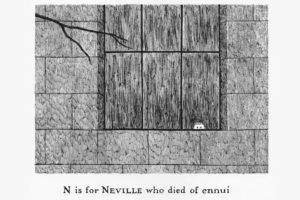Cartooning History, Lessons #243 – 247
Skip to comments
The Origins of Gorey’s The Gashlycrumb Tinies
Gorey’s darkly droll tales touch—lightly—on weighty matters: the death of God, the meaning of life, and, always and everywhere, our impending mortality. Emblems of innocence and naïveté, children make perfect victims, as Gorey told the New Yorker. “It’s just so obvious,” he said. “They’re the easiest targets.”
Gorey wrote The Gashlycrumb Tinies at a time when he was in the doldrums professionally if not creatively. He had landed a job at the New York publisher Bobbs-Merrill, where from ’62 through ’63 he spent a dispiriting year as art director. A Wildean aesthete who sported a beard of Old Testament proportions and liked to swan around in floor-length fur coats, Gorey bridled at the stuffy corporate atmosphere and managerial incompetence. (He and his similarly disgruntled coworkers referred to their employer as “Boobs Muddle.”)
Marc Dery, author of Born to Be Posthumous: The Eccentric Life and Mysterious Genius of Edward Gorey, looks at the life of Edward Gorey leading up to the creation of The Gashlycrumb Tinies and examines the work itself.
Those Girly Gag Cartoon Magazines
Joke books and magazines had been around since the beginning of print. Likewise, cartoon- and comic-books had been printed for decades before the War. But it was World War II that brought about the great popularity of gag-cartoon digests and magazines. Soldiers had very little spare time, whether on base or out in the field of combat, and so they wanted things that could be read in short spurts. Comics were better than novels, not because of quality but rather due to brevity.

Neil Robertson looks at those humor magazines in a number of columns
illustrated with plenty of covers and cartoons.
Introduction
Part One
Part Two
Part Three
Part Four
Part Five
Part Six
Part Seven
Socialist Cartoonist vs. The 1%
Last year’s publication of Fantagraphics’ To Laugh That We May Not Weep gave historian R. C. Harvey the incentive for a lengthy essay profiling master cartoonist Art Young.
In 1902, Young had returned to Wisconsin briefly to lend his pen to Robert La Follette’s Progressive (Republican) campaign to be re-elected governor. But by 1905, Young had rejected the Republican politics of his heritage— including “all bourgeois institutions.” And he had resolved never again to draw a cartoon whose ideas he didn’t believe in.
Harvey’s profile at The Comic Journal site.
Joel Beck’s Comics and Stories
As a founder of the underground comix movement Joel Beck’s career began in the early 1960s.
His influential comic Lenny of Laredo, a “loose” biographical allegory on the life of Lenny Bruce and the Berkley Free Speech Movement, pretty much created the underground comics extravaganza of the 60’s . . .
Here’s a profile. And here’s a biography from the Joel Beck site.
A New Yorker Album or Two
Michael Maslin takes a look at a seminal New Yorker collection…
The New Yorker Album Of Drawings 1925 – 1975; a proven time-tested book that never ever fails to thrill and inform — I learn something whenever I look through it.
and then the follow up a decade later, noting a few historical oddities.






Comments
Comments are closed.